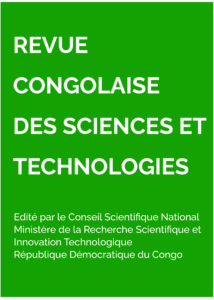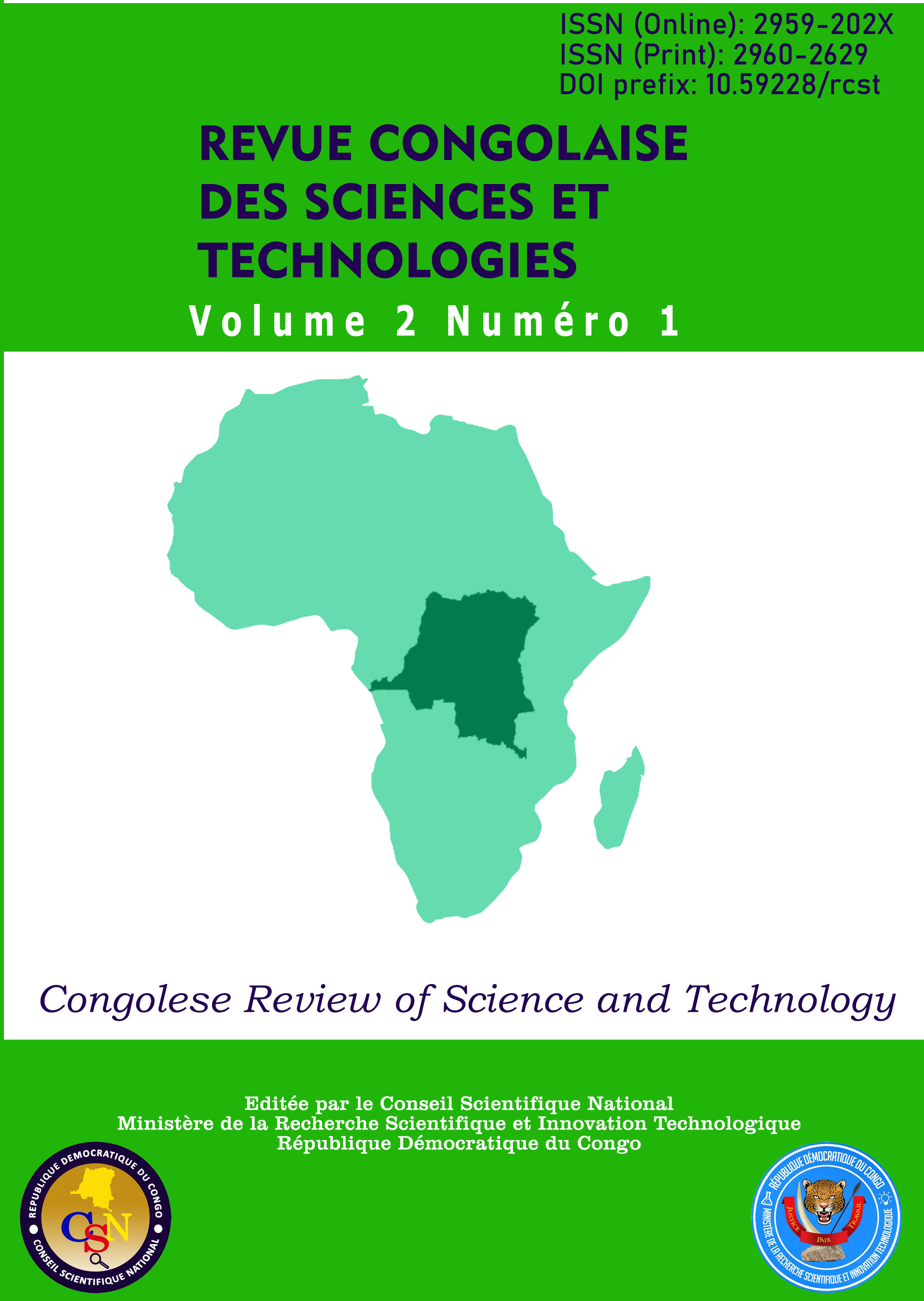Stress at work among administrative agents in Higher and University Institutions of the city of Uvira, Democratic Republic of the Congo
Main Article Content
Abstract
The purpose of this study is to analyze the prevalence, the impact on performance and the stress-generating problems among
administrative agents in higher and university education institutions in the city and territory of Uvira. It is a cross-sectional
descriptive study carried out among 86 administrative agents in 3 higher education and university institutions in Uvira out of the 4 in
the city of Uvira, from March to November 2022. After analysis, all respondents claim to be informed about stress, and of all 79%
prove their good knowledge by correctly defining stress. The prevalence of stress among agents is 96.4%. Of all, in the state of stress
85.4% say they are very disturbed and therefore cannot work. At 89.2% the daily production is disturbed by the occurrence of stress
in the agent and the intellectual capacity of the stressed person does not function normally. Some main factors were identified as
causes of stress among the officers surveyed, including: at 54.2% Insufficient salary, poor working conditions comes with 26.6%,
duties related to 16.8% and others . In view of the foregoing, it is important that the government, which is the employer, revise
upwards the salaries granted to administrative staff in higher and university education, thus enabling them to meet basic needs. Thus,
the Management Committees to be able to create a favorable working climate and good collaboration and/or communication between
the hierarchy and the agents
Article Details

This work is licensed under a Creative Commons Attribution-NonCommercial-ShareAlike 4.0 International License.
References
Afaf, A.B. & Naouel H. (2021). Stress au travail et
incertitude de l’avenir professionnel. Revue
El-Tawassol, 27(02), 128-141.
Bourhis, A. (2009). La Gestion de Ressources
Humaines pour les managers. Paris, Editions
du Renouveau Pédagogique Inc.
Caron, J., Lecomte Y, Stip E. &Renaud S. (2005).
Predictors of quality of life in schizophrenia.
Community Mental Health Journal, 41(4),
-417.
Chini, B. (2001). Évaluation quantitative du stress
dans une population de salariés des régions
Haute et Basse-Normandie. Archives des
maladies professionnelles et de médecine du
travail, 62(7), 536-545.
Cintas, C. & Sprimont, P.A. (2011). Soutien social et
violence au travail: Quels effets sur le
burnout? Post-Print hal-02091821, HAL.
Daniel, C. O. (2019). Effects of job stress on
employee’s performance. International
Journal of Business, Management and Social
Research, 6(2), 375-382.
Davis, S., Lind, B.K. &Sorensen, C., (2013). A
comparison of burnout amongoncology nurses
working inadult and pediatricinpatient and
outpatient settings. Oncol. Nurs. Forum. 40
(4), E303–E311.
http://dx.doi.org/10.1188/13.ONF.E303-E31.
Foglia, D.C., Grassley, J.S. & Zeigler, V.L. (2010).
Factorsthat influence pédiatric intensive care
unit nurses to leavetheir jobs. J. Crit. Care
Nurs. Q, 33(4), 302–316.
http://dx.doi.org/10.1097/CNQ.0b013e3181f6
Frimousse, S., Hofaidhllaoui, M., Swalhi, A., &
Zgoulli, S. (2013). L’épuisement des cadres
au sein des PME: Le Rôle de
l’employabilité. Acte du 24ème Congrès.
Consulté le 2/01/2023.
https://www.agrh.fr/assets/actes/2013-
frimousse-alii.pdf
Gintrac, A. (2011). Le stress au travail, un état des
lieux. Revue Management et avenir, 1(41), 89-
Hamaideh, S.H. (2012). Occupational stress, social
support, and quality of life among Jordanian
mental health nurses. Issues Ment Health
Nurs, 33(1), 15-23.
Harnois, C., Picard, K., Rivard, S., Tremblay, J. F., &
Gosselin, É. (2021). La dynamique du
stress au travail est-elle transactionnelle? Ad
machina, (4), 75-90.
Kabuo, M.K. (2022). Gestion psychologique de stress
en milieu professionnel et prevention. RevueInternationale des Sciences de Gestion, 5(4),
–922.
Larosa, R.E., Le Clesiau, H., Dubois, G., Izard , J. L.,
Bonin, M., Bordron, J. & Neveu, D. (2013).
Évaluation du stress au travail après mesures
de prévention dans une caisse de
retraite. Revue Santé publique, 25(1), 59-67.
Mushagalusa, D.B., Iinnocent, S.N., Nkulu, L.N.,
Ilunga, M.K. & Ngoy, D.W.K. (2021). Le
stress au travail et l’épuisement professionnel
du personnel soignant de l’Hôpital Général de
Référence de Gemena/Sud-Ubangi en
République Démocratique du
Congo. International Journal of Social
Sciences and Scientific Studies, 1(2), 16-29.
Pari, P. (2009). Conditions de travail et stress chez le
personnel des services administratifs et
techniques de l’université de Lomé. Journal
de recherche scientifique de l’Université de
Lomé, 11(1), 107-24.
Portes, É. (2012). Démarche de prévention du stress
au travail en milieu de soins : le rôle de
l’infirmier de santé au travail. Recherche En
Soins Infirmiers, 110(3), 90–96.
https://doi.org/10.3917/rsi.110.0096
Sapp, A.L., Kawachi, I., Sorensen, G., LaMontagne
A.D. & Subramanian S.V. (2010). Does
workplace social capital buffer the effects of
job stress? A crosssectional, multilevel
analysis of cigarette smoking among U.S.
manufacturing workers. J. Occup. Environ
Med., 52(7), 740-5
DOI10.3917/spub.131.0059.https://www.cairn
.info/revue-sante-publique-2013-1-page
htm
Sekol, M.A. & Kim, S.C. (2014). Job satisfaction,
burnout, and stress among pediatric nurses in
various specialty units at an acute care
hospital. J. Nurs. Educ. Pract, 4(12), 115–123.
http://dx.doi.org/10.5430/jnep. v4n12p115.
Sillamy, N. (1991). Dictionnaire de la psychologie
(2è
edition). Paris, Librarie Eyrolles.
Soedje, K.M.A., (2022). Stress au travail chez les
enseignants du primaire public de la ville de
Lomé (Togo): profil professionnel et aspects
cliniques. Revue Africaine et Malgache de
Recherche Scientifique/Sciences de la
Santé, 3(1), 25-37.
Tidjani, B. & Kamdem, E. (2010). Gérer les
ressources humaines en Afrique. Entre
processus sociaux et pratiques
organisationnelles. Paris, Editions EMS.
Tshikala, M.K.P., Bitambile, B.N.F. & Musasa, J.N.,
(2016). Burnout, un tueur silencieux dans
quelques institutions publiques deLubumbashi. Revue la recherche Qualitative,
(2), 500-514.
Valentin, G., Lucas, JP, Bougeant, JC, & Chaïban, J.
(2017). État de stress post-traumatique chez
les marins et addiction: étude de cas
rapportés. Archives des maladies
professionnelles et de
l'environnement, 78 (3), 282-287.

